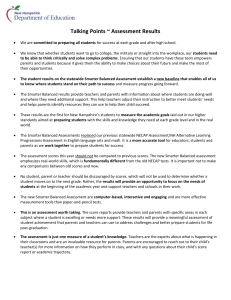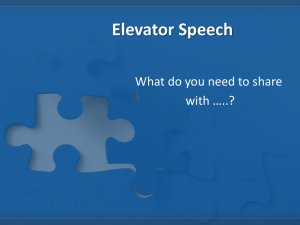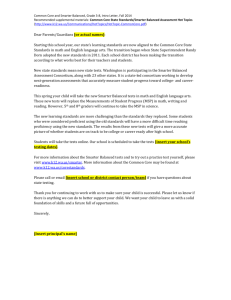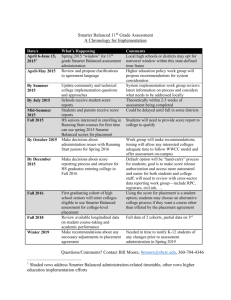Higher Education Placement Agreement FAQ
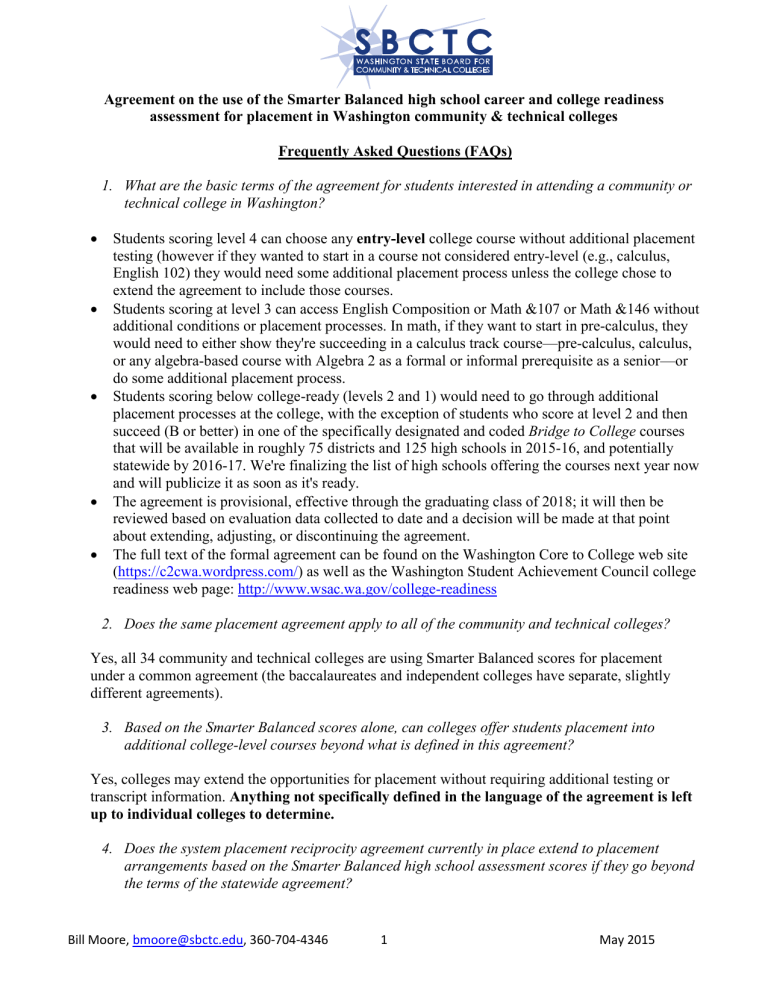
Agreement on the use of the Smarter Balanced high school career and college readiness assessment for placement in Washington community & technical colleges
Frequently Asked Questions (FAQs)
1.
What are the basic terms of the agreement for students interested in attending a community or technical college in Washington?
Students scoring level 4 can choose any entry-level college course without additional placement testing (however if they wanted to start in a course not considered entry-level (e.g., calculus,
English 102) they would need some additional placement process unless the college chose to extend the agreement to include those courses.
Students scoring at level 3 can access English Composition or Math &107 or Math &146 without additional conditions or placement processes. In math, if they want to start in pre-calculus, they would need to either show they're succeeding in a calculus track course—pre-calculus, calculus, or any algebra-based course with Algebra 2 as a formal or informal prerequisite as a senior—or do some additional placement process.
Students scoring below college-ready (levels 2 and 1) would need to go through additional placement processes at the college, with the exception of students who score at level 2 and then succeed (B or better) in one of the specifically designated and coded Bridge to College courses that will be available in roughly 75 districts and 125 high schools in 2015-16, and potentially statewide by 2016-17. We're finalizing the list of high schools offering the courses next year now and will publicize it as soon as it's ready.
The agreement is provisional, effective through the graduating class of 2018; it will then be reviewed based on evaluation data collected to date and a decision will be made at that point about extending, adjusting, or discontinuing the agreement.
The full text of the formal agreement can be found on the Washington Core to College web site
( https://c2cwa.wordpress.com/ ) as well as the Washington Student Achievement Council college readiness web page: http://www.wsac.wa.gov/college-readiness
2.
Does the same placement agreement apply to all of the community and technical colleges?
Yes, all 34 community and technical colleges are using Smarter Balanced scores for placement under a common agreement (the baccalaureates and independent colleges have separate, slightly different agreements).
3.
Based on the Smarter Balanced scores alone, can colleges offer students placement into additional college-level courses beyond what is defined in this agreement?
Yes, colleges may extend the opportunities for placement without requiring additional testing or transcript information. Anything not specifically defined in the language of the agreement is left up to individual colleges to determine.
4.
Does the system placement reciprocity agreement currently in place extend to placement arrangements based on the Smarter Balanced high school assessment scores if they go beyond the terms of the statewide agreement?
Bill Moore, bmoore@sbctc.edu
, 360-704-4346 1 May 2015
No. As defined in the placement reciprocity agreement, colleges would be bound by the broad terms of the system-wide Smarter Balanced policy agreement but not necessarily by placement arrangements colleges make that go beyond that agreement. Decisions to accept those additional arrangements would be left up to local colleges.
5.
Will Smarter Balanced scores from students from other states be honored?
Yes, level 3 and 4 Smarter Balanced scores will be honored regardless of where the student takes the assessment. The statewide level 2 agreement is dependent on students taking the Washington-specific transition courses being developed in math and English, so without that course no statewide level 2 agreement is available for out-of-state students.
6.
Are the scores from the Smarter Balanced high school assessment used as part of the admissions process at Washington baccalaureate institutions?
No. However, Washington baccalaureate institutions want to support the implementation of the
Common Core and encourage students to achieve these higher standards, and agree in principle that the more information institutions have about student academic performance, the better. The decision about whether, and if so, how, to incorporate the scores into the admissions process will be reviewed by individual baccalaureate institutions as part of reassessing the recommendations during the winter
2018, based on the additional data to be available by that time.
7.
Will Smarter Balanced scores be used for placement into both English and math courses and any other courses that require those subjects as prerequisites?
No, the primary focus and intent of the policy was for placement into English 101 (composition) and specified entry-level math classes; offering placement into other courses would be at the discretion of local colleges.
8.
Can students choose any course in a course sequence up to the course/s offered as part of the agreement?
Yes, the placement agreement is an option offered to students, so students are free to choose a
“lower” course in the course sequence than what is offered by the placement agreement.
9.
How does the agreement affect students in professional-technical pathways?
A student who places into college-level English or math would also have a professional-technical writing or math course placement honored.
10. Are additional placement processes available to all students if they want a higher-level course than what is specified in the agreement?
Bill Moore, bmoore@sbctc.edu
, 360-704-4346 2 May 2015
Yes, if students would like a placement other than what's offered by the Smarter Balanced score they can pursue whatever other options are offered by the college—transcript, placement test, etc.—and take the highest placement available to them.
11. In the agreement what does the reference to “terminal” math courses mean?
“Terminal” was initially assumed to include any entry-level math course that could serve as the last or only math course the student would need to take to fulfill program or transfer requirements, with the exception of pre-calculus. For the statewide placement agreement, the only qualifying courses are Math& 107 (Math in Society) and Math& 146 (Statistics). Additional courses can be included at the discretion of local colleges.
12. What’s considered “calculus pathway” in high school in order for students scoring at level 3 to qualify for placement into pre-calculus?
The intent of the agreement language was to ensure that students would be taking a rigorous level of math in the senior year; any algebra-based courses in the high school math course sequence (with
Algebra 2 as a formal or informal prerequisite) would qualify as “calculus pathway.”
13. What high school senior-year math courses can students scoring at level 2 take as seniors that will allow them to get the same automatic placement as students who scored at level 3—is it only the official Bridge to College Math transition course, or are other post-Algebra 2 courses acceptable?
For now, the statewide placement agreement requires that students scoring at level 2 complete the official Bridge to College Math transition course (and earn a B or better grade) as seniors to get the automatic placement deal offered to students scoring at level 3 as juniors. Local colleges can extend that agreement to include additional algebra-intensive courses (with Algebra 2 as a formal or informal prerequisite) in the high school math course sequence based on local transcript-based placement discussions, an option that would be particularly useful in the short term given that only slightly more than one-quarter of districts in the state will be offering the transition course in 2015-
16.
14. Will a student who takes pre-calculus as a high school junior with an A or B in the class and who scores at level 3 on the Smarter Balanced assessment have to take calculus as a high school senior in order to get a placement into a “calculus pathway” course? (A student who is in Algebra 2 as a junior and scores at level 3 would only have to take pre-calculus as a senior.)
Scoring at level 3 can be combined with pre-calculus or its equivalent as the highest math taken
(whether it be senior or junior year) to qualify for pre-calculus placement per the placement agreement. Students succeeding in pre-calculus as juniors should be encouraged to take a rigorous math class as seniors.
15. English Smarter Balanced scores can be used for placement any time during the first academic year for students immediately following high school graduation; math scores can only be used in the
Bill Moore, bmoore@sbctc.edu
, 360-704-4346 3 May 2015
initial (fall) quarter. Can colleges modify the agreement locally to extend the timeframe for math to match English?
Yes; the terms of the system-wide agreement will be revisited at the end of the provisional period.
16. What if a student re-takes the Smarter Balanced assessment as a senior and gets a higher score?
Although at this time no statewide decisions have been made about funding re-takes on the high school assessments, as the Smarter Balanced assessment is phased in as a graduation requirement districts will need to offer a re-take opportunity for any students scoring below college-ready (levels
1 and 2). If students earn a higher score then they will follow the placement option recommendation for the higher level based on the re-test score.
17. How does this agreement apply to Running Start and other dual credit programs for high school students?
For students who want to take Running Start or another dual-credit course as seniors, the Smarter
Balanced would apply just as it does for students entering college after high school. At present, students who want to begin Running Start as juniors (before they’ve taken the Smarter Balanced assessment) would need to qualify for college-level work through whatever process currently exists at the college offering the credit. After taking the Smarter Balanced high school assessment in the spring of their junior year (or for English Language Arts, in their sophomore or junior years), these results could then be used to qualify for college-level courses in English or math through Running
Start.
18. Are the current required high school assessments—the 10 th grade High School Proficiency Exam
(HSPE) in English Language Arts and the math end-of course exams (Algebra I and Geometry)— given any consideration by higher education as part of this agreement?
No. The HSPE has been eliminated and is no longer being offered to students as of spring 2015, replaced by having 10 th
graders take the high school Smarter Balanced assessment in English
Language Arts. For math, the end-of-course assessments are still required for graduation but are being phased out, with the new Smarter Balanced assessment becoming the requirement for the class of 2019. At the present the Smarter Balanced high school assessment is the only assessment clearly developed for and aligned to the college and career readiness standards in the Common Core so it is the only assessment addressed in this agreement. Regardless of whether the Smarter Balanced assessments are required for graduation, the purpose of the agreement is to encourage students to meet the new higher standards defined by the Common Core, using the Smarter Balanced high school assessment as the key performance metric.
19. If 10 th
-grade students are taking the Smarter Balanced high school assessment in English
Language Arts, are their scores included in the placement agreement?
Yes, the community and technical college agreement has been updated so that these students are included; the agreement will allow 10 th
grade students scoring above the Smarter Balanced-defined threshold for college-readiness to be able to use that score to place into an English Composition course through Running Start (as a junior or senior) or when they enter college after their high
Bill Moore, bmoore@sbctc.edu
, 360-704-4346 4 May 2015
school senior year. [Note: per current legislative requirements, 10 th
grade students are taking the high school Smarter Balanced assessment in English Language Arts only along with the 11 th
grade students. If they achieve a college-ready (levels 3 or 4) score they will be able to “bank” the score and not take the ELA assessment as juniors. ]
20. What senior-year “pathways” to college readiness are available to students scoring below college-ready (level 1 in particular) on the high school assessment?
The statewide automatic placement agreement applies only to students who score in the level 2 range on the Smarter Balanced assessment; for students scoring in the level 1 range local school districts will need to define viable pathways to college readiness, possibly in partnership with area colleges.
For example, districts may opt to make the senior year college readiness/transition course available to students scoring at level 1 and then provide a retest opportunity. If a student retests and earns a higher score then he/she follows the placement option recommendation for that level. Colleges may also develop a more expansive local agreement with specific local districts that would include level
1 students based on the Smarter Balanced score, transcript information, GPA, or additional high school information.
21. If a Running Start student has passed a college-level course that requires college-level skills, why wouldn’t that student automatically receive the equivalent of a 4 (college readiness) on the
Smarter Balanced assessment?
A key purpose of the Smarter Balanced assessment system is to replace the federal accountability testing system for K-12 schools (required for grades 3-8 and high school), so that’s the reason why high school students are required to take the test. Beyond that, the assessments are intended to provide clear and detailed feedback to students and schools about progress toward achieving the
Washington K-12 Learning Standards in English Language Arts and math as defined by the
Common Core. Given that college courses—and by extension, grades in those courses—aren’t designed to reflect the Common Core State Standards, there’s no guarantee that because a Running Start student passes a college course he or she has achieved those standards. If Running
Start juniors are truly “college-ready” in terms of the Common Core standards, they should have no problem scoring well on the Smarter Balanced assessments.
22. How will the Smarter Balanced scores be reported to higher education for the purpose of applying the placement agreement?
For now students are being asked to provide a copy of their score report—hand-delivered if necessary—to the college they are attending if they want to use their scores for placement purposes.
SBCTC is currently working with OSPI to develop a statewide process for data-sharing and student consent; students will provide consent and authorize access to their test score data when they register or request placement at a higher education institution. College staff will need to input the data into college data system until automated process can be developed through ctcLink. For the initial implementation colleges will be able to access Smarter Balanced scores (level, scale scores, claims scores) and high school math/English course-taking as needed for placement purposes. The goal is to have this system operational in time for students entering college in fall 2016.
Bill Moore, bmoore@sbctc.edu
, 360-704-4346 5 May 2015
Process of Developing the Agreement
A cross-sector work group recruited from a variety of key education stakeholder groups and representing
K-12, community and technical colleges, and baccalaureate institutions convened in November 2013 to produce an initial draft of the recommendations for using of the Smarter Balanced 11 th
grade assessment as an indicator of college readiness in the placement process for postsecondary institutions in
Washington.
The draft recommendations were then publicized widely January through March 2014 at various stakeholder group meetings and through a web-based survey and comment process. The feedback received was compiled and categorized in early April 2014, after which the policy work group reconvened to review a revised set of recommendations based on the feedback received. The group then produced this final version of the agreement for consideration by higher education institutions in April-
May 2014.
For more details about the work group or questions about the overall process, please contact Bill Moore,
Director, K-12 Partnerships, State Board for Community & Technical Colleges, bmoore@sbctc.edu
,
360-704-4346.
Background and Rationale for the Agreement
Washington is among 40+ states, 2 territories and the District of Columbia implementing the K-12
Common Core State Standards (CCSS) for college- and career-readiness in English Language Arts and
Mathematics. The standards represent a critical shift in state standards for K-12 students, setting consistent, high, research-based expectations for all students anchored in a clear vision of the knowledge and skills students need to succeed in first-year college courses and postsecondary professional-technical programs. The CCSS were developed through a multi-state, state-led process that involved higher education representatives from the outset – and continued collaboration will be critical for success.
Successful statewide implementation of the CCSS will increase significantly the college readiness of
Washington high school graduates and reduce their need for precollege work in higher education
(ultimately saving money for both students and colleges).
To establish clear and consistent assessments of these rigorous new standards for college and career readiness, two multi-state consortia have developed state-of-the-art assessments that will replace the existing K-12 student assessments required for federal accountability, effective spring 2015. Washington is a member of the Smarter Balanced assessment consortium; the other consortium is called PARCC
(Partnership for Assessing Readiness for College and Careers). Both assessment systems will offer student assessments in grades 3 through 8 and in high school to meet federal accountability guidelines and to provide clear feedback to students and key stakeholders about whether students are on track to be college and career ready by graduation.
By current Washington state legislation, the 11 th
grade Smarter Balanced assessment will be required for high school graduation for the Class of 2019 (with a separate graduation performance standard yet to be set but very likely to be below the college-readiness performance level defined by the Smarter Balanced consortium). In the absence of a clear college-readiness benchmark for high school graduates in
Washington there will continue to be a gap between academic preparation in high school and the
Bill Moore, bmoore@sbctc.edu
, 360-704-4346 6 May 2015
skills/knowledge expectations for succeeding in entry-level college courses, increasing the need for meaningful incentives to encourage student achievement of the new standards.
As part of the Smarter Balanced Assessment Consortium Washington has been asked as a state to decide whether and how the 11 th
grade assessment will be used in placement decisions for high school graduates entering higher education . The use of the SBAC 11 th grade scores in higher education as a meaningful indicator of college readiness will help encourage students to meet the CCSS standards.
Considering these scores as part of the placement process is also timely as national research continues to question the quality and efficacy of existing placement tests.
1
Most Washington public higher education institutions are examining the predictive power of the tests being used for placement, shifting away from single point in time placement test scores toward multiple or alternative measures that provide a richer understanding of student potential for success in college-level work, such as transcript-based placement efforts. Incorporating Smarter Balanced 11 th grade scores into these ongoing efforts provides real advantages over existing testing alternatives: a) Cost.
The test will be taken by all high school juniors and funded as part of the K-12 state assessment system. b) Variety and Level of Expectations . Students will encounter new item types, computerenhanced items, many more constructed-response items, and performance tasks that ask them to write and to use a broad array of knowledge and skills to solve complex real-world problems. c) Transparency and Ownership . The test has been designed and will be overseen through the
Smarter Balanced consortium of states with ongoing input from hundreds of teachers, higher education faculty, state content specialists and testing experts. The key documents describing the assessment (content specifications, item specifications, item writing training materials, test blueprints, accommodations framework, achievement level descriptors, technology specifications, etc.) are available to the public on the Smarter Balanced website.
1 e.g., recent work from the Community College Research Center
Bill Moore, bmoore@sbctc.edu
, 360-704-4346 7 May 2015
